One day, sitting on a bench in Assisi, I look out across the valley below. Olive trees frame the pink and white stone walls of the Basilica di Santa Chiara. Beautiful medieval buildings line cobblestone streets. The sun glistens — it has been unrelenting all day. The mountains cradle the landscape like a hug, protecting the ancient villages that sit on their hilltops.
There is an expression I’ve heard here: una rondine non fa primafera. But now there are so many swallows chasing each other across the valley that we can be sure that spring is in full swing.
Italy’s effortless beauty is hard to fathom. It feels like the land has been kissed by the gods. In fact, the fields here actually glow. I guess it’s no wonder that Italy was conquered by so many societies over the ages, and many of its cities have Ancient Roman, Etruscan, Umbrian, or Ancient Greek history. In Umbria (and much of the rest of Italy for that matter), the towns are almost always built on hills — a reminder of the constant threat of attack in the Middle Ages (and earlier).
Everyone wanted what they had.
I feel blessed to have experienced a taste of what life is like in this beautiful country. I have just spent a month in Perugia (the capital city of Umbria) studying Italian at the Università per Stranieri di Perugia.
It was very important to me that I did this during my time here, because when I first travelled to Italy with my partner in 2022, I did not speak a single word of Italian. This made it very difficult for me to communicate with his family. (Thankfully, the shared language of food and his excellent translation skills helped bridge the gap!)
But I love learning languages and already speak French (which is very similar linguistically), so one of my big goals for this sabbatical was to get to a basic, conversational level of Italian for future travels and family visits.
Little did I know what other treasures Umbria had in store for me. Beautiful new friendships, fascinating history, and some of the most stunning architecture in Italy, to name only a few. These are some of the many reasons that this past month has been one of the happiest of my life.
This newsletter has probably been the hardest to condense so far. But here are some of my highlights from Perugia and the regions of Umbria and Tuscany, with a few tips for restaurants, sights, and experiences along the way.
A Magical Month Studying Italian in Perugia
I arrived in Perugia late at night, at the start of May. I was welcomed by rain and the twinkling lights of houses on hilltops. Even this small taste of the city’s beauty made me feel a huge sense of anticipation — like a magician was about to reveal his trick.
Sure enough, the next morning, I woke up to sun, colour, noise, and the smell of coffee. I walked to the University, which is housed in a large pink Palazzo next to the Arco Etrusco, a giant, well-preserved Etruscan arch from the 4th century BC. I could hardly believe that this was going to be my life for the next month.
In fact, it was quite amazing that I had even made it there in the first place.
The University did not make it easy to enrol. They do not pick up the phone, all instructions and communications are in Italian, and we did not receive a confirmation email with our class schedule until a couple of days before the course started. This was my first test for becoming Italian!
But the benefit of all this rigmarole was that I was surrounded by people who were thrilled to be there too. Warm, friendly, and open people of all age groups and corners of the world, who were brought together by a shared connection with the Italian language and culture.
It’s safe to say, I fell in love with Perugia. Not only is it smaller, quieter and less touristy than other cities in Italy, but it is also stunningly beautiful, relaxed, and just big enough to have all the amenities you need. Plus, did I mention that it’s known for chocolate?! It’s home to the Perugina chocolate factory (which makes the famous Baci chocolates). Fabian even gifted me an incredible class at the Scuola del Cioccolato at this very factory, which was certainly one of my most memorable birthday gifts!
The city is a fantastic launching point for exploring other towns in Umbria, with plenty of bus and train connections, and one of the most ridiculous forms of transport I’ve ever seen — the MiniMetro. While I originally had grand plans about going back to Rome to eat at Roscioli just one more time, or going back to Florence to see the beautiful Ponte Vecchio again, I quickly realised just how much incredible goodness there was to see within the Umbria region itself.
A Chance Encounter
There were several ‘pinch-me’ moments throughout the month. But there was one that particularly struck me, one rainy day.
One of the beautiful things about Perugia is its position on top of a large hill, surveying many of the neighbouring towns, such as Assisi and Spello. Near the Giardini Carducci there is a large panorama, where you can see the Basilica di San Domenico and San Pietro. You can also see the collecting of clouds, and a wall of rain coming towards you when the weather turns — which would give me precisely 10 minutes to get home dry.
One afternoon, I took my time, slowly making my way back home, and the onslaught of rain hit me before I could even make it back to Porta Pesa. I ran up some stairs, saw a building with an open door and ran inside for cover. Seeing a light leading me down a hallway, I followed it.
I soon realised that what I’d walked into was actually the Chapel of San Severo, a building featuring a 15th century fresco by none other than Renaissance master Raphael, and his teacher Perugino.
Listening to the rain pounding on the roof, I scanned every inch of the painting, in awe of one of my favourite artist’s beginnings, and how extraordinary it is, what has transpired (and been recorded) in this location over hundreds and thousands of years.
The Perfect Day in Perugia
After a jam-packed month trying to see as much as I could, I think I have finally designed the perfect day in Perugia. So to anyone visiting, let’s say with only a day or two to spare, this would be my advice to you:
Start your day with a caffè and cornetto in one of the many bars and pasticcerias in town (my favourite was my local, Bar Pasticceria 2000, which is run by two matriarchs).
Then, take a stroll into Centro, admiring the Umbrian hills along the way.
Do a lap from the famous Fontana Maggiore (which is a popular meeting spot), to the other side of town — all the way to the Giardini Carducci. Enjoy the beautiful view of the hills and surrounding neighbourhoods!
Now, it’s time for pasta... if you’ve got time to spare, head to Osteria a Priori for some incredible wine and traditional Umbrian fare. If you’re after a quick meal instead, grab some epic takeaway pasta from Il Tiesto for just 9 euros!
Afterwards, pop into the Bar Pasticceria dell'Accademia for a coffee and biscotto.
Then, walk to the Abbazia di San Pietro (in my opinion, the most beautiful cathedral in Perugia). Go inside, and make sure to visit the Medieval Botanical gardens. Alternatively, you could go to the Chiesa di San Michele Arcangelo, one of the oldest churches in Perugia, which features columns from a 5th-6th C pagan temple.
Stop back via Augusta Perusia for the best gelato in Perugia
Finally, finish the day with ‘apericena’ at Punto di Vista for the best views and vibes in town!
Above all, the best part of my stay was that I achieved my goal. From speaking Italian every day in class, on the street, and practicing with friends, I feel that I improved a lot (just don’t ask me anything in the future tense). I had such a fantastic time at the uni (shout out to Christina and Rachele, the best teachers!) and I would highly recommend this experience to anyone.
Day Trip Highlights
Visiting Assisi, one of the most important religious sites in Italy
There is no doubt that there is something deeply spiritual about Assisi. It is the birthplace of San Francesco, who started the Franciscan religious order and is one of the patron saints of Italy. Santa Chiara was also born there, who founded the Order of the Poor Clares. It is also the resting place of Carlo Acutis, who is about to become the first Millennial saint. Even the surrounding olive trees have a religious quality, a constant reminder of God’s presence in this country.
The Basilica di San Francesco is one of the most beautiful cathedrals I have ever been inside. In the upper cathedral, there are frescos that detail the story of San Francesco’s life, and in the lower cathedral, frescos by Giotto that mark a turning point in art history towards the Renaissance.
I was also in awe of the views from the Rocca Maggiore, the medieval castle at the top of the hill, and had a lovely lunch at Le Terrazze di Properzio, which surely has one of the best views in town (and also one of the best tortino al cioccolato).
Finally, if all that wasn’t awe-inspiring enough, Assisi also features the remains of an old Roman forum and an ancient Roman temple that now forms part of the Church of Santa Maria sopra Minerva.
A typical day trip in the Tuscan and Umbrian countryside, with new friends
I was very lucky to meet some lovely new friends in Perugia, who took me on a day trip to explore the nearby towns of Pienza, Castiglione del Lago, and Bagno Vignoni, situated near the famous Val d’Orcia in Tuscany, and Lake Trasimeno in Umbria.
The rolling hills of the Val d’Orcia are UNESCO World Heritage, and the neighbouring towns have rich food cultures, which local osterias are keen to show off.
We sat down at one such restaurant for lunch in Pienza, a place called Sette di Vino. The sign read “Non si prenota a pranzo” (At lunch, we don’t take bookings), and before we even had a chance to grab a table, the owner told us “La pasta, non la fo’ ” (We don’ do pasta). On the menu was largely written, “Il caffè non c’è” (No coffee).
We couldn’t help but wonder what this place did actually do.
It turned out they did serve very authentic, delicious Tuscan fare. Very ‘poor’ recipes from the past that have now become popular — such as white bean soup, artichokes, chickpeas, and cured meats such as salami and Lardo di Colonnata, served with unsalted bread (something unique to both Tuscany and Umbria).
As we sat and enjoyed, the owner shouted at people waiting in line “If you’re in a hurry just leave, I don’t need you”. Ahh, the characters of Italy.
After exploring the spectacular natural beauty of the countryside, visiting the thermal baths at Bagno Vignoni and strolling through the walled town of Castiglione del Lago, we finished the day with apericena at a trendy winery called Madrevite, looking out over another lake and watching the sunset. It was simply perfect.
I went home feeling so grateful and happy for a wonderful day together.
Sightseeing in Siena
Americans. Americans, everywhere.
This was my first impression of Siena, much like other popular Italian tourist spots Florence and Rome.
But with that out of the way, Siena was actually very beautiful. I particularly loved the green spaces surrounding the city — such as the very pleasant walk to the Orto dei Pecci, and the Medici Fortress that looks out on a view of the entire city.
The Piazza del Campo was a stunning meeting place, and the Siena Cathedral was a marvel. I actually wasn’t aware before visiting Siena and Orvieto that a similar colourful style to the Florence Duomo was used across other parts of Italy.
Siena was also the place where I tried my first porchetta sandwich, and it was EPIC.
Orvieto and Spoleto (because I can’t choose between them)
I could see how some people might say that once you’ve visited one Italian town in Umbria, you’ve visited them all. There are stunning views, great food, charming streets, and inspiring cathedrals in each one.
But if you’re someone (like me) who never tires of experiencing these things, and will appreciate the subtle differences between each one, it is well worth seeing all there is to see in Umbria and Tuscany. I still have many, many more towns I learned about on my list for when I return one day!
I loved my day trips to both Orvieto and Spoleto, mostly because their cathedrals were extraordinarily unique, and both towns offered such spectacular views. Spoleto’s Duomo features beautiful colourful frescos from Renaissance artist Filippo Lippi, and is also his resting place. Orvieto’s cathedral is one of the best preserved facades I’ve seen in the country, with sculpted doors and striking colours.
Plus, it is just a pleasure to stroll through the streets of these towns, tasting all of the beautiful food on offer, and gazing upon the surrounding greenery from up high.
I should also offer a special mention to Spello, which can be visited in an afternoon if short on time, and is known for the beautiful flowers that adorn each street.
A Note on Happiness
One day (of many), I was sitting in the sun, eating pasta, drinking wine, and looking out at yet another beautiful view. I felt completely at ease, with plenty of time in the day left to enjoy.
I wondered whether this might be the peak of happiness (or at least contentment). And I can say with some certainty that this past month in Perugia, I have been the happiest I’ve ever been.
Italy is probably the country where I have always made the most vivid memories. And my (completely unscientific) theory is that the country engages every one of the senses (sight, sound, smell, taste, touch) in ways that other countries don’t, which in turn consolidates and solidifies connections in the brain forming memory.
I’ve been reflecting on what it is that has made me so delighted every day. In fact, looking back on my notebook, this is the topic I wrote most about during my time in Perugia.
There is, of course, the superficial. Every day is filled with such beautiful moments to look forward to. The first sip of a caffè macchiato al banco accompanied with a cornetto al cioccolato. The feeling of warmth on the skin as the sun rises over the Umbrian hills. The beauty of the medieval and Etruscan architecture walking through Centro Storico. The taste of delicious pasta over lunch with a leisurely glass of wine. The entertaining people-watching, as Italians passionately go about phone calls, animated confrontations at the post office, and road rage in their cars. The comfort that an evening passeggiata with friends brings.
Each of these moments pulls you directly into the present — and as I learned during my time in Thailand, this is an absolutely key component of happiness.
Then, I think there is the deeper feeling of connection. As I learned more about the history of Perugia, and the important religious and historical sites I discovered in neighbouring towns, I felt a sense of connection to human history — who we are as a race, who has been before us, what they’ve created (and destroyed) and why. The city and region of Perugia have fabulous Ancient Etruscan, Umbrian and Roman history, which I learned all about at the fantastic Archaeology museum near the grand Basilica di San Domenico.
In a way, it gives a sense of context and perspective on your own life and identity. This is also one of the reasons I am so passionate about learning languages — you gain a much better insight into a culture when you can understand and converse with people in their first language.
I also found this month had a sense of balance. For me, importantly, every day was spent learning — whether it be learning Italian at the university, learning about other cultures from the new friends I made, learning about history or art in a museum, or just keeping my eyes open on the street. I was also incredibly active, constantly walking and hiking up massive staircases, running, and doing pilates. I built lovely relationships with beautiful and kind people while going to class, out to dinner, or grabbing an aperitivo.
And finally, in Italy you just eat really great quality food. All the time. What more could one want?
But let’s face it, it’s easy to be happy in Italy on holidays. I am under no illusions that what I experienced during my month in Italy was the ‘vacation’ version, and that the country faces all sorts of diverse challenges for those who live and work there (as locals remind me). However, I’m excited to have learned a few more things about finding awe in the every day to bring back to my lifestyle at home in Australia.
Reads on the Road
Babel by R.F. Kuang
I read Yellowface by R.F. Kuang for book club last year, and earlier this year I saw Kuang speak live at the Opera House in Sydney for the All About Women festival. She’s one of the best spoken authors I’ve ever seen (I guess no surprises there, being an Oxford and Cambridge graduate). I’d heard that Babel was her best work so far, and while visiting Oxford recently I thought it would be the perfect book to accompany my journey.
The book is what she calls ‘dark academia fantasy’, and it explores how languages are used to expand Empire. I found it quite an accomplishment of a book. There’s a lot of research that’s gone into this on linguistics, the history of Oxford, and Imperialism, and the idea is strikingly original. It’s a very engaging read… but long. I felt it got off track towards the end, and the characters became less believable and relatable, so found it difficult to finish! But overall, it’s an impressive work that I would recommend.
Thanks for reading! I am currently in the English countryside, relaxing and catching my breath before heading back on the road again. Next stop, Morocco!
One last thought I wanted to leave you with…
When I was in Paris, I discovered an Annie Ernaux quote “J’ai cherché à pratiquer une sorte d’écriture photographique du réel" — she has tried to practice capturing scenes like a photographer through her writing (an admirable goal).
But it is my view that the beauty of Italy cannot be captured without being experienced. No words or photographs (or even newsletters) could capture the smell of jasmine and pine in the spring air, the contrast of the green olive groves and scarlet poppies tumbling over rolling hills, the hum and ‘putt putt’ of Pandas and Fiat 500s, the first taste of gelato on a sunny day, or the balance of a white boar ragù sauce with the chewy texture of strangozzi.
So my advice… Go out and experience it for yourself!

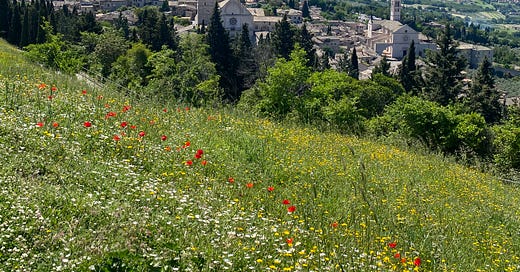




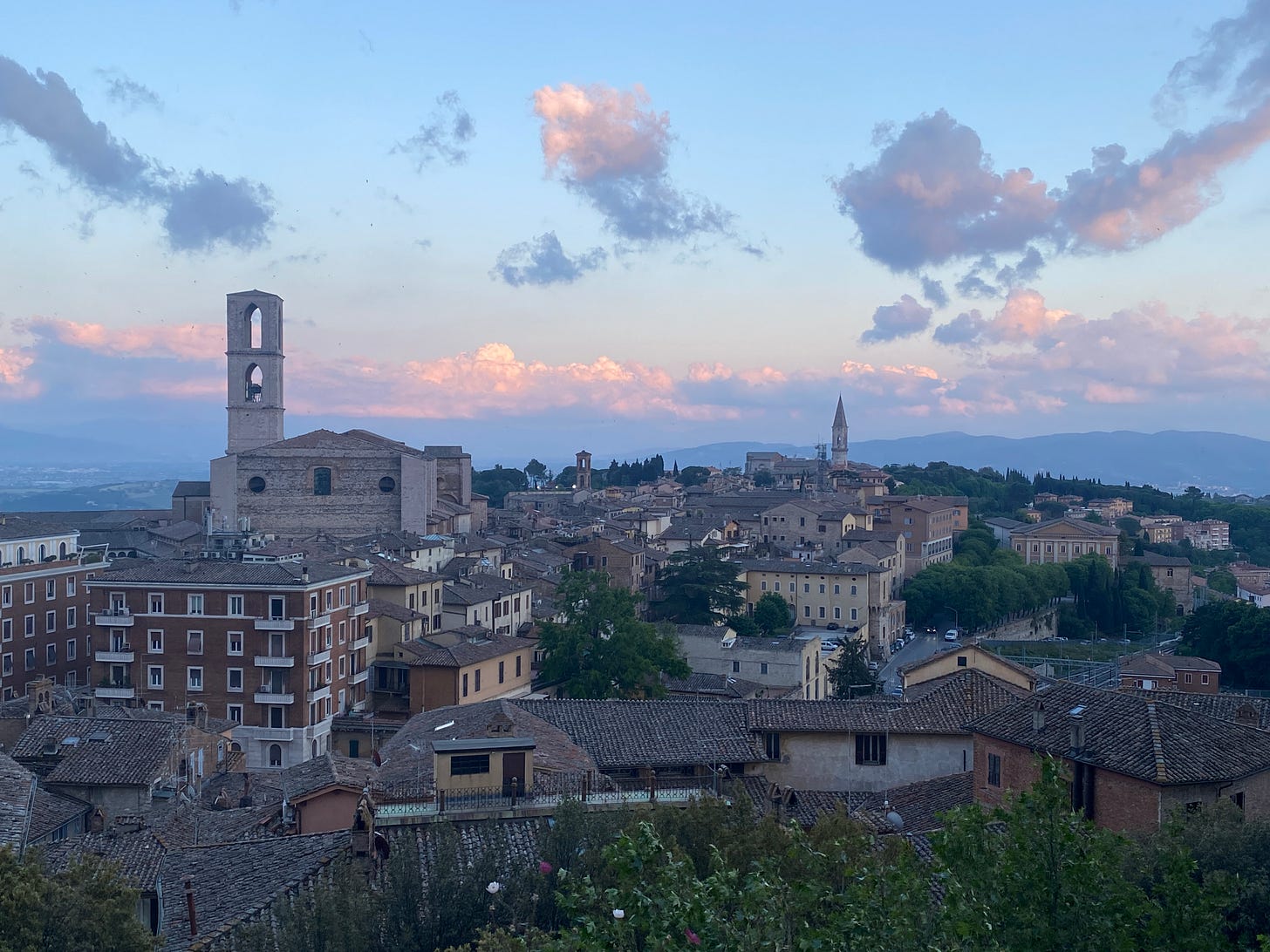

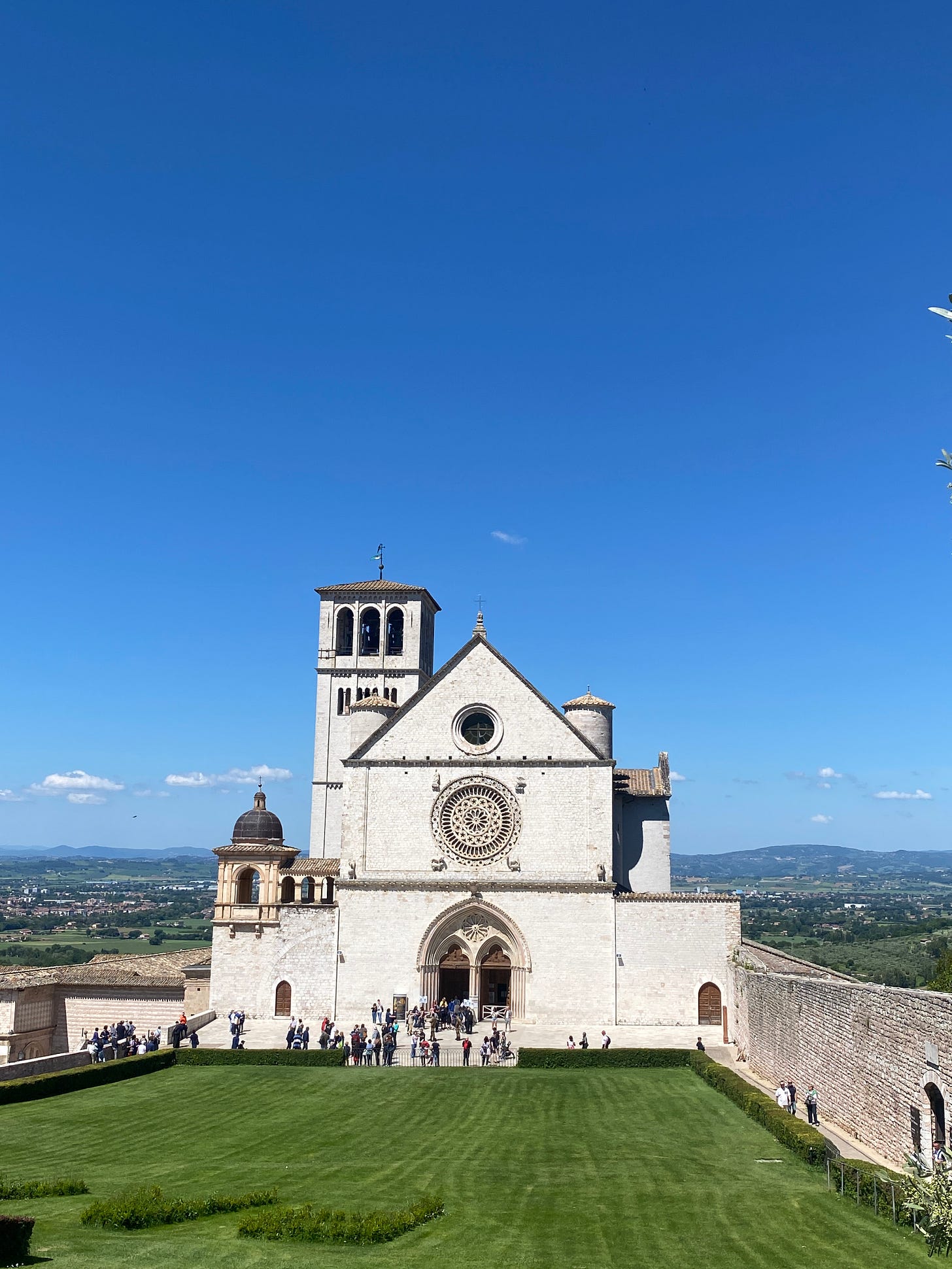


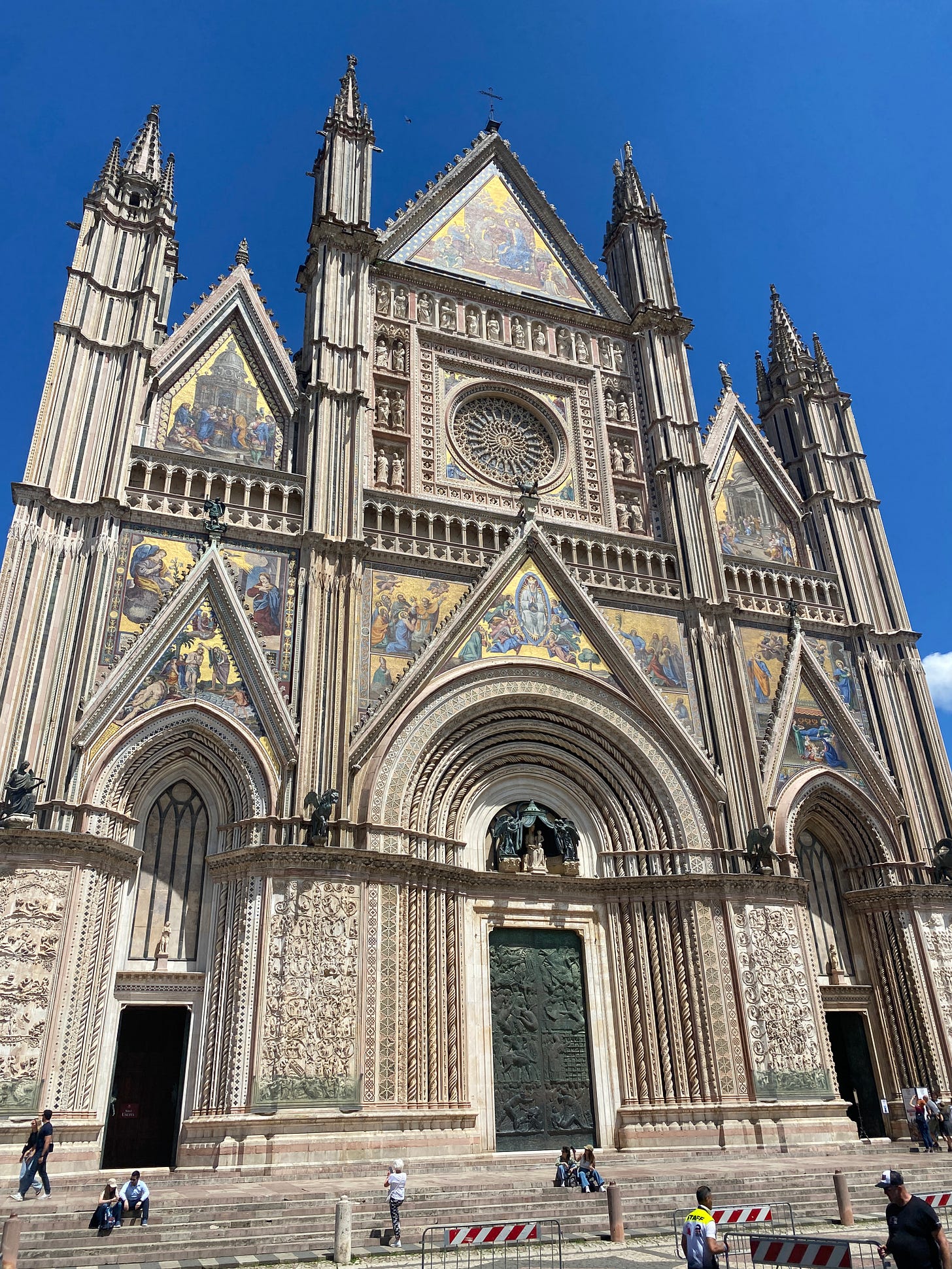
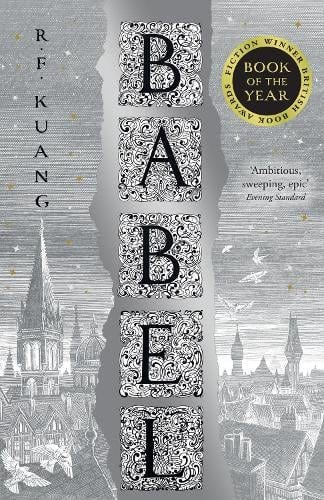
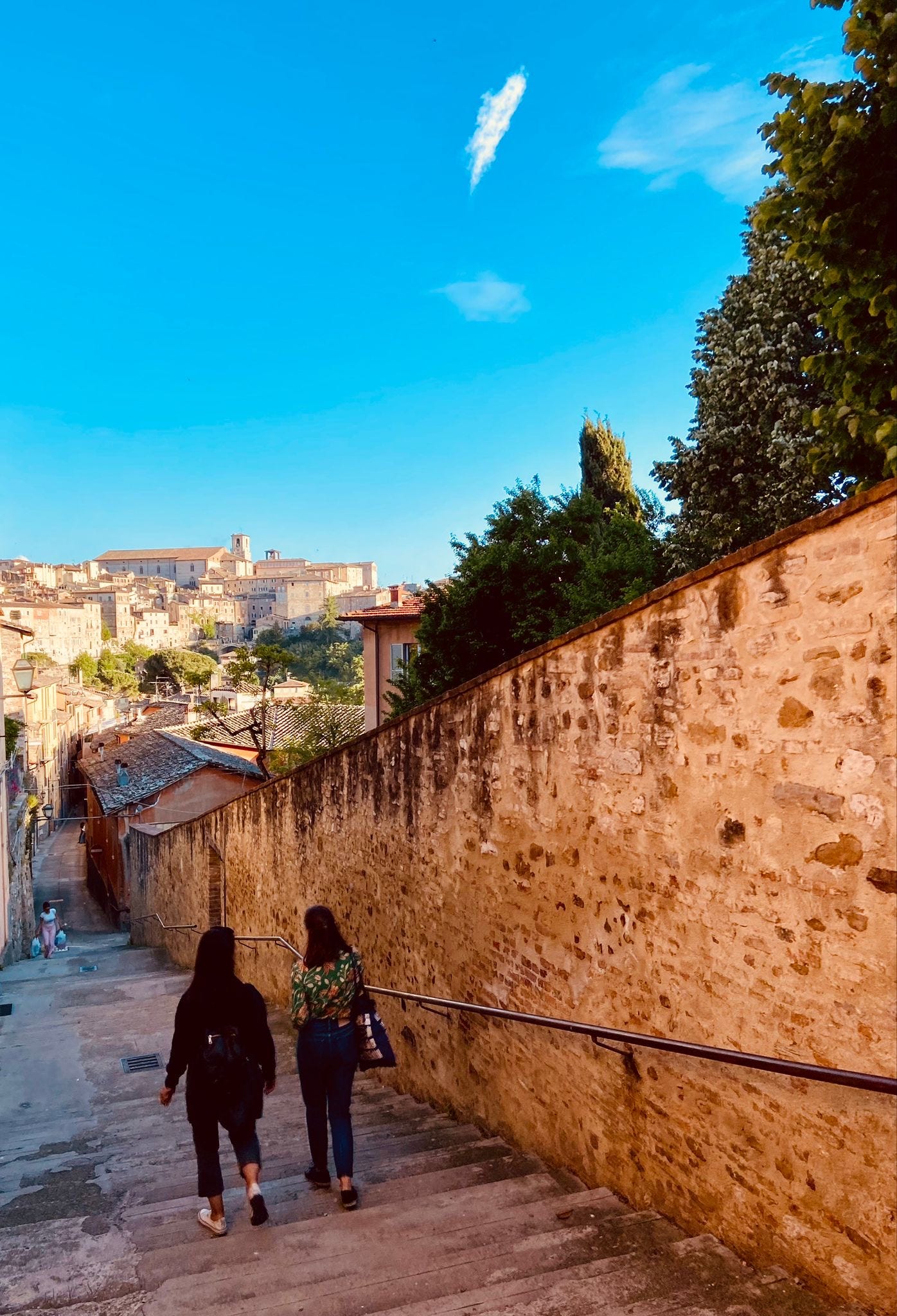
Erin, such beautiful described scenery ,it makes us feel like we,re travelling with you.Your so lucky to be able to see so much of the world while your young.It will. be better when Fabian comes over in August.I love the chapel,that you ran in to get out of the rain.You we’re meant to see the beautiful work.Stay safe, love Aunty Jen and Uncle Darrell xx